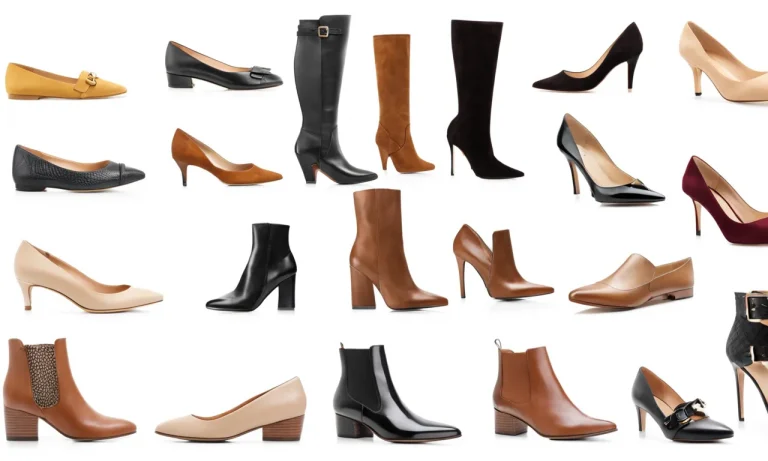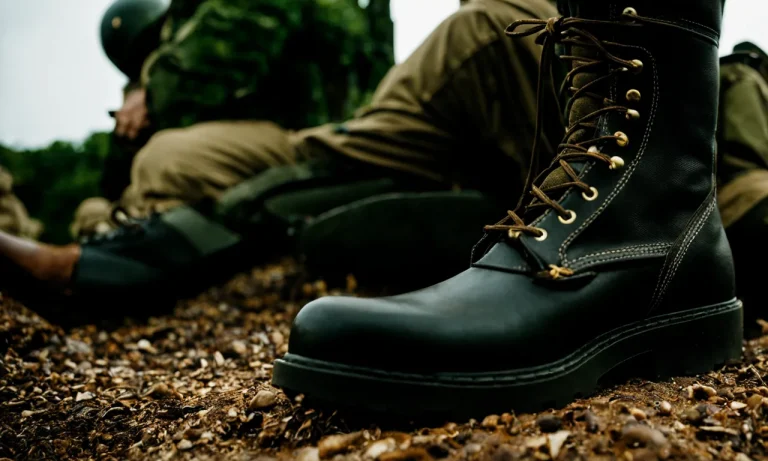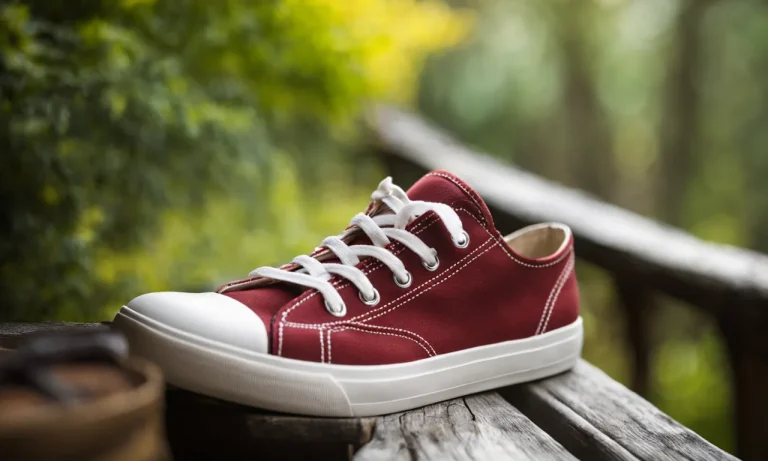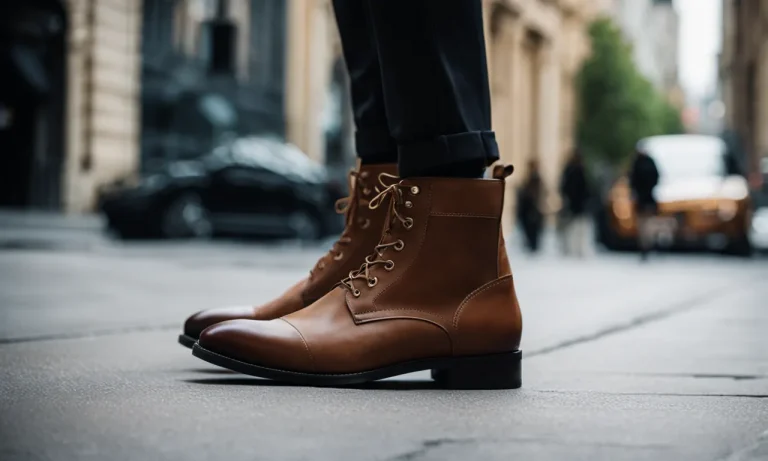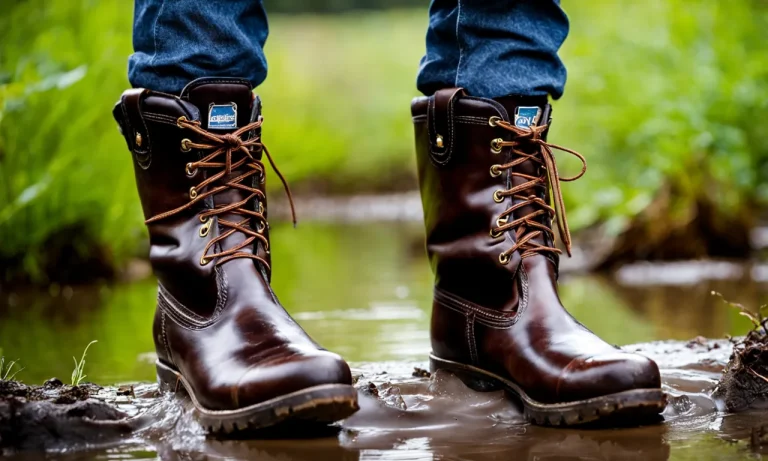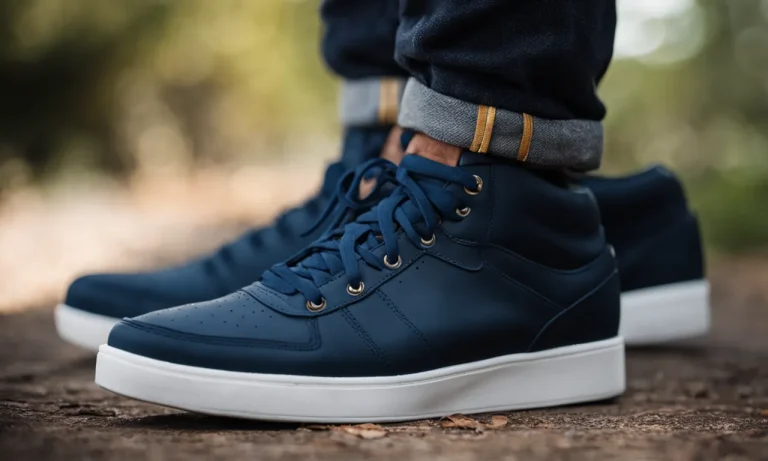Have you ever slipped on your favorite pair of shoes only to feel your big toe jamming into the front? This uncomfortable and sometimes painful issue is common for many foot shapes and shoe styles. Luckily, with some simple tips, you can stop your big toe from hitting the top of your shoe.
If you’re short on time, here’s a quick answer: Your big toe likely hits the top of your shoe because the style is not suited for your foot shape and size. Wearing properly fitted shoes with a roomy toe box can help prevent rubbing and discomfort.
In this comprehensive guide, we’ll explore all the reasons your big toe may hit the top of your shoe. You’ll learn about common culprits like narrow toe boxes, improper sizing, foot conditions like bunions, and more.
We’ll also provide solutions to stop the irritation through proper fit, sizing up, shoe stretchers, and appropriate shoe styles.
Causes of a Big Toe Hitting the Shoe Upper
Have you ever experienced the frustrating sensation of your big toe hitting the top of your shoe? It can be uncomfortable and even painful, making wearing certain shoes a challenge. There are several common causes for this issue, and understanding them can help you find solutions and prevent further discomfort.
Let’s explore the main culprits behind why your big toe hits the shoe upper.
Narrow or Tapered Toe Boxes
One of the most common causes of a big toe hitting the shoe upper is narrow or tapered toe boxes. Many shoe styles are designed with a narrower toe area, which can squeeze and put pressure on your toes. This can be particularly problematic if you have wider feet or a larger big toe.
The lack of sufficient space in the toe box can force your big toe to push against the top of the shoe, causing discomfort and pain.
Insufficient Toe Room from Improper Sizing
Another culprit behind your big toe hitting the shoe upper could be an issue with the sizing of your shoes. If your shoes are too small or not the right size for your feet, you may not have enough room in the toe box for your toes to move freely.
This can lead to your big toe hitting the top of the shoe as you walk or engage in physical activity. It’s essential to ensure that your shoes are properly sized and provide enough room for your toes to avoid this issue.
Foot Conditions Like Bunions or Hammertoes
Foot conditions such as bunions or hammertoes can also contribute to your big toe hitting the shoe upper. These conditions cause the big toe joint to protrude or bend in abnormal ways, making it more likely to come into contact with the top of the shoe.
If you have bunions or hammertoes, it’s crucial to choose shoes that accommodate the shape and size of your feet to minimize discomfort and prevent further aggravation of these conditions.
High-Heeled Shoes
Wearing high-heeled shoes can also increase the chances of your big toe hitting the shoe upper. The elevated heel position in these shoes can shift your body weight forward, causing your toes to be pushed into the front of the shoe.
Additionally, high heels often come with narrow toe boxes, exacerbating the issue. If you frequently wear high-heeled shoes, consider opting for styles with wider toe boxes or lower heel heights to alleviate the pressure on your toes.
Pointed Toe Styles
Similarly, shoes with pointed toe styles can lead to your big toe hitting the shoe upper. The tapered shape of these shoes can restrict the movement of your toes and cause them to be pushed towards the front of the shoe.
If you prefer pointed toe styles, look for options that provide enough room in the toe box or consider going up a size to prevent your big toe from hitting the shoe upper.
Inadequate Width
Inadequate width is another potential cause of your big toe hitting the shoe upper. If your shoes are too narrow for your feet, it can compress your toes and force them to contact the top of the shoe. Opting for shoes with wider widths or brands that offer various width options can help alleviate this issue and provide a more comfortable fit.
Excessive Mileage and Wear
Over time, shoes can become worn out and lose their original shape and support. Excessive mileage and wear can cause the toe box to shrink or deform, leading to the big toe hitting the shoe upper. Regularly replacing your shoes and inspecting them for signs of wear can help prevent this issue from occurring.
Remember, it’s essential to find shoes that fit properly and accommodate the shape and size of your feet. If you continue to experience discomfort or pain despite trying different solutions, it’s advisable to consult a podiatrist for professional guidance.
How to Stop Big Toe Irritation
Dealing with big toe irritation can be incredibly frustrating and uncomfortable. Fortunately, there are several steps you can take to alleviate this issue and ensure a more comfortable fit for your shoes.
Size Up for More Toe Room
One common reason why your big toe may be hitting the top of your shoe is because the shoe is simply too small. To combat this, try sizing up to provide more room for your toes to move freely. Remember, your feet can change size over time, so it’s important to have your feet measured periodically to ensure you are wearing the correct size.
Choose Shoes with a Wide or Round Toe Box
Another option to consider is choosing shoes that have a wider or rounder toe box. This will give your toes more space to spread out and reduce the likelihood of them hitting the top of your shoe. Look for shoe brands that specifically cater to individuals with wider feet or offer styles with roomier toe boxes.
Use Shoe Stretchers to Widen Narrow Shoes
If you have a pair of shoes that are too narrow in the toe area, you can use shoe stretchers to widen them. Shoe stretchers are devices that can be inserted into your shoes and then expanded to stretch the material.
This can help create more space for your toes and alleviate any irritation they may be experiencing.
Modify Shoes for Extra Space
If you have a pair of shoes that you love but they are consistently causing toe irritation, you can consider modifying them to create more space. This can be done by taking them to a professional shoe repair shop and asking them to stretch or widen the toe box.
Keep in mind that not all shoes can be successfully modified, so it’s important to consult with a professional before making any alterations.
Consider Custom Orthotics
In some cases, big toe irritation may be caused by an underlying foot condition such as a bunion or hammertoe. If this is the case, custom orthotics may be recommended. These are specially designed shoe inserts that can help correct any structural issues with your feet and provide additional support and cushioning.
Consulting with a podiatrist is the best way to determine if custom orthotics are necessary for your specific situation.
Wear Appropriate Socks
The type of socks you wear can also play a role in preventing big toe irritation. Opt for socks made from moisture-wicking materials that provide cushioning and support. Avoid socks that are too tight or have seams that can rub against your toes and cause discomfort.
Break in Shoes Slowly
If you’ve recently purchased a new pair of shoes and are experiencing big toe irritation, it’s possible that the shoes simply need to be broken in. Avoid wearing them for long periods of time initially and gradually increase the duration as the shoes become more comfortable.
This will allow your feet to adjust to the shoes and minimize any potential irritation.
Remember, everyone’s feet are unique, so it may take some trial and error to find the best solution for your specific situation. By following these tips and exploring different options, you can effectively stop big toe irritation and enjoy a more comfortable shoe-wearing experience.
When to See a Podiatrist
If you’re experiencing any of the following issues with your big toe hitting the top of your shoe, it may be time to schedule an appointment with a podiatrist:
Unrelenting Discomfort and Pain
If you find that your big toe consistently hits the top of your shoe, causing discomfort and pain that doesn’t go away, it’s important to seek professional help. A podiatrist can assess the underlying cause of the problem and provide appropriate treatment options to alleviate your pain.
Toe Deformities Like Bunions
Toe deformities such as bunions can lead to your big toe hitting the top of your shoe. Bunions are bony bumps that develop at the base of the big toe and can cause significant discomfort. A podiatrist can evaluate your bunions and recommend treatment options, such as orthotics or surgery, to address the issue.
Numbness or Tingling
Experiencing numbness or tingling in your big toe can be a sign of nerve compression or damage. This can cause your toe to hit the top of your shoe. A podiatrist can perform a thorough examination and recommend appropriate treatment, which may include physical therapy or medication.
Corns, Calluses, or Ulcers
Corns, calluses, or ulcers on your big toe can make it more likely to hit the top of your shoe. These conditions often develop due to excessive pressure or friction on the skin. A podiatrist can provide effective treatment options to alleviate these issues and prevent further complications.
Difficulty Walking
If your big toe hitting the top of your shoe is causing difficulty with walking or affecting your mobility, it’s crucial to seek professional help. A podiatrist can assess your gait and provide solutions to improve your walking ability, such as custom orthotics or physical therapy.
Toenail Issues
Issues such as ingrown toenails or fungal infections can lead to pain and discomfort in your big toe, causing it to hit the top of your shoe. A podiatrist can address these toenail problems and recommend appropriate treatments, such as nail removal or antifungal medication.
Foot Swelling
Foot swelling can cause your big toe to hit the top of your shoe due to the increased pressure on the toes. This swelling can be caused by various factors, including injury, inflammation, or underlying medical conditions.
A podiatrist can identify the cause of the swelling and provide appropriate treatment options to reduce it.
Remember, it’s important to consult with a qualified podiatrist to accurately diagnose and treat any issues with your big toe hitting the top of your shoe. Seeking professional help can help alleviate your discomfort and prevent further complications.
Preventative Tips for a Comfortable Fit
Measure Feet Annually
One of the most important steps in preventing your big toe from hitting the top of your shoe is to ensure you are wearing the correct shoe size. Feet can change in size over time, so it is recommended to measure your feet annually.
This can help you identify if you need to adjust your shoe size and prevent any discomfort.
Shop for Shoes Later in the Day
Did you know that our feet tend to swell throughout the day? That’s why it’s best to shop for shoes later in the day when your feet are at their largest size. By doing so, you can ensure that the shoes you purchase will provide a comfortable fit even when your feet are slightly swollen.
Always Try Shoes On
While it may be tempting to buy shoes online without trying them on first, it’s always recommended to try shoes on before making a purchase. Each shoe brand and style may fit differently, so trying them on allows you to assess the fit and ensure that your big toe has enough room to avoid hitting the top of the shoe.
Focus on Toe Box Roominess
The toe box is the area of the shoe that surrounds your toes. To prevent your big toe from hitting the top of your shoe, it’s crucial to choose shoes with a roomy toe box. Look for shoes with sufficient space for your toes to move and wiggle comfortably without any restrictions.
Select Appropriate Heel Height
The heel height of a shoe can also impact the fit and comfort. If you find that your big toe often hits the top of your shoe, consider opting for shoes with a lower heel height. Lower heels can help redistribute weight more evenly, reducing the pressure on your toes and preventing any discomfort.
Choose Breathable Materials
When selecting shoes, it’s essential to consider the materials used. Opt for shoes made from breathable materials such as leather or mesh. These materials allow air circulation, keeping your feet cool and preventing excessive sweating, which can lead to discomfort and potential rubbing against the top of the shoe.
Replace Well-Worn Shoes
Over time, shoes can become worn out and lose their shape, leading to a poor fit. If you notice that your big toe is hitting the top of your shoe frequently, it may be a sign that your shoes are worn out and need to be replaced.
Regularly inspect your shoes for signs of wear and tear and replace them when necessary.
Consider Custom Orthotics
If you have persistent issues with your big toe hitting the top of your shoe, it may be beneficial to consider custom orthotics. These are specially made shoe inserts that provide additional support and cushioning.
Custom orthotics can help alleviate any foot imbalances or abnormalities that may be causing your toe to hit the top of your shoe.
Trim Toenails Straight Across
Proper toenail maintenance is crucial to prevent discomfort and avoid your big toe hitting the top of your shoe. Trim your toenails straight across and avoid cutting them too short. This can help prevent ingrown toenails and ensure that your toenails don’t rub against the top of your shoe.
Conclusion
If your big toe constantly rubs against the top of your shoes, you don’t have to live with the pain and discomfort. By understanding the potential causes and making a few simple changes, you can stop your toe from hitting the shoe upper.
Focus on proper sizing, adequate width, roomy toe boxes, and shoe modification to create a comfortable space for your feet. And don’t hesitate to see a podiatrist if you have ongoing issues or foot deformities causing the irritation.
With the right footwear and professional help if needed, you’ll be on your way to happy, pain-free feet.

